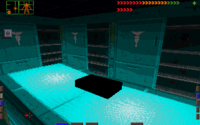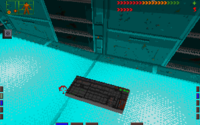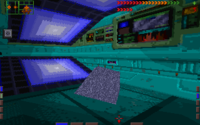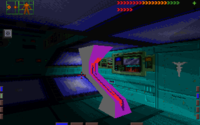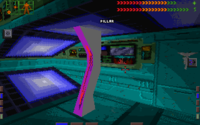This is a sub-page of System Shock (1994).
There are several objects defined in OBJPROP.DAT which do not appear in the game.
The sections for object classes on this page refer to the names of classes as referred to by the game's source code.
| To do:
Replace some of these screenshots with better 3D model renders. |
Dummy Model

The dummy model replacing a healing station.
The file OBJ3D.RES contains definitions for 3D models numbered 0 through 79, used for various decorative objects throughout the game. Approximately 20 of these aren't used by any objects, and all resolve to the same "dummy" model. The model resembles a small green airplane with one wing fading between light and dark green; it may have been initially used to test 3D models in the game before any proper 3D objects were implemented.
(Source: Original TCRF research)
Physics (class 02)
- Drone camera (subclass 02, type 00)
- Explododrone (subclass 02, type 01)
- These two dummied-out objects probably would have behaved similarly to their counterparts in Terra Nova: Strike Force Centauri, which was partially developed at the same time as System Shock.
Hardware (class 05)
- View control unit (subclass 01, type 05)
|
|
This is the hardware that allows you to switch between full screen or normal view. You're never able to pick it up in-game, since you already have this hardware immediately after starting the game, but an object exists for it nonetheless. If placed in a level, you can still pick it up and equip it if the version number is higher than normal, but upgrading this hardware doesn't actually do anything.
There is also an MFD background icon for it in the file MFDART.RES, although you never see it, since its "item" panel contains various visual settings instead.
|
|
- Aim enhancement hardware (subclass 00, type 03)
|
|
An unused hardware item. It has its own background icon for the "Item" panel, but doesn't have an actual description. It appears in the Hardware inventory menu, but doesn't show up among the hardware icons on either side of the screen. The effect this hardware would have is fairly obvious from the name, but when enabled, it doesn't actually seem to do anything.
|
|
- Head-up display goggles (subclass 00, type 04)
|
|
Another unused piece of hardware. It has a background icon, though the game doesn't display it for some reason. This item may have been intended to serve the same purpose as the actual MFD display, which you never actually have to "get", as it's built into your head from the beginning of the game.
Curiously, the background icon resembles the aim enhancement's sprite, while the object's sprite itself resembles the Sensaround's background icon.
|
|
- Attempting to turn this hardware on doesn't have any visible effects at first, but attempting to search a corpse or container with it activated causes a partially visible, unusable "search" panel to appear at the top of the screen rather than the bottom, suggesting that the game's interface may have originally had a different design. Doing this can also cause the game to stop responding to the player's input, for some reason, although it's still possible to move the cursor.

Pre-release screenshot showing all of the available hardware. Notice the "AIM" and "HUD" selections. (Source:
Interactive Entertainment, June 1994)
- Both the aim enhancement and HUD goggles can be seen in a few pre-release screenshots, though they don't really provide any clues as to how exactly they would have worked.
Software (class 06)
In addition to the few unused hardware items, there is a good deal of unused software. Almost all of these have MFD background icons in MFDART.RES. Very few of these items are actually usable.
In a feature from the March 1995 issue of PC Gamer, it is mentioned that "while Cyberspace was originally conceived as a realistic hacking simulation—which could even be used to reimplement SHODAN's ethical constraints—it was simplified after Origin Systems deemed it too complicated." These items are probably all remnants from that original concept.

Firing a Datastorm projectile
- Datastorm (assault software) (subclass 00, type 01)

|
This weapon software can be picked up in cyberspace and used. It shoots small red triangular projectiles, but these do not actually do any damage.
|
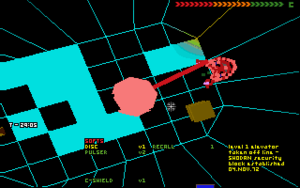
Firing a Disc projectile.
- Disc (heavy attack program) (subclass 00, type 03)

|
This is another somewhat functional weapon software. This weapon's projectile is a red-tinted version of the "data node" objects, although it may have used a different model at some point during development. The projectile object's short name is "TRON DISC". Like the Datastorm projectile, it does no damage.
|
- Mine (explosive module) (subclass 00, type 02)
- Scrambler (software grenade) (subclass 00, type 05)


- These two weapon softwares can be picked up, but do not do anything when used.
- Virus (some cool thing) (subclass 00, type 06)
- This software displays the message "item rejected" when you attempt to pick it up. A "destroyed virus" type also exists with the rest of the container and corpse types, along with unused "destroyed" versions of the other cyberspace programs; this suggests that it may have been intended to let you summon "friendly" programs that would attack cyberspace enemies.
- Old fake ID (subclass 01, type 01)
- ICE shield (subclass 01, type 02)


- These also display the message "item rejected" when you attempt to pick them up. Although they can't be added to the inventory through normal means, they have background icons anyway.
- Monitor (subclass 03, type 01)
- Identify (subclass 03, type 02)
- Trace (subclass 03, type 03)
- Toggle (subclass 03, type 04)




- These also display the "item rejected" message. They are part of the same subclass as the Trioptimum Fun Pack Module, suggesting that they probably would have been for use outside of Cyberspace.
- Map segment (subclass 05, type 00)
- This may have been intended to automatically map out parts of the level for you when picked up.
Big Stuff (class 07)
- Floor lamp (subclass 03, type 01)
- Glow bulb (subclass 03, type 02)


- Two unused types of light sources. Could have been used in any number of places. Technically, these objects do appear in cyberspace, but the game treats them as software with the same subclass and type values, as a hack to get around the number of software objects that can be placed in a single map.
- VCR (subclass 00, type 01)
- It's a VCR. Presumably, Trioptimum finally decided to switch to optical media at some point. The model also lacks a texture, suggesting it was scrapped relatively early into development (or maybe it never had one to begin with).
- Keyboard (subclass 00, type 04)
- It's a keyboard. Probably scrapped because it would have looked a little bit out of place.
- Control panel (subclass 05, type 05)
- This resembles a wider version of some of the "control pedestal" objects, with similar texturing and blinky lights. Just like the control pedestal, this can be made to trigger other objects or display a security camera view. Might have simply been scrapped in favor of the smaller electronics models.
- Probe (subclass 05, type 02)
- This is in the same subclass as the security camera, and may have been intended as an additional security device. The model seems to be oversized or poorly scaled.
- Statue (subclass 06, type 00)

|
Dummied out object in the "plants" subclass, probably would have appeared in the groves somewhere. The only graphical remnant is the map editor icon (shown here at 400% size), which is too small to be of any real use.
|
- Vine (subclass 06, types 07 and 08)


- Two more unused grove objects. While there are still plenty of vines around, they only appear in the form of textures, not sprites.
- Rock (subclass 06, type 11)
- This is an object in the "plants" subclass, probably intended for use in the groves.
- Boulder (subclass 06, type 12)

|
This probably would have been similar to "rock", but uses the dummy model. However, if you change its render type from 1 (model) to 2 (sprite), it becomes something which clearly isn't a boulder.
The sprite used for this object is actually used in Terra Nova: Strike Force Centauri, which was in development at the same time despite being released about two years later.
|
- Brass railing (subclass 07, type 04)
- Wooden railing (subclass 07, type 05)
- Two 3D railing objects that could have been used on the executive level, the groves, or a number of other places.
- REALWALL (subclass 07, type 02)
- A solid rectangular object with an obvious placeholder texture. May have been used to test collision with 3D models.
- Pillar (subclass 07, type 03)
- Pillar (subclass 07, type 06)
- Slightly complex models with similar placeholder textures. Probably used for the same purpose as "REALWALL".
- Tubing (subclass 04, type 01)
- Uses the dummy model.
- Broken lab equipment (subclass 04, type 07 & 08)
- Two dummied-out objects that probably would have showed up on the medical and/or research levels somewhere.
Small Stuff (class 08)
- Warecasing (subclass 00, type 03)
|
|
An unused item of the same "junk" subclass as the beverage can, fire extinguisher, etc. It cannot be picked up; double-clicking on it gives you the "can't use" message instead.
|
- Telescoping rod (subclass 03, type 02)
|
|
An unused item found alongside the useful half of the "general" inventory items, namely the probes, batteries, and first aid kits. It has a unique background graphic for the "item" panel, but has no description. Holding it in hand allows you to interact with switches, doors and other objects from a greater distance than usual.
|
|
- Tractor beam (subclass 03, type 04)
|
|
Another unused item in the same category. It also has a unique background graphic, but no description. Unlike the telescoping rod, it can actually be turned on/off by the player. When activated, it consumes energy at a rate of 32 JPM, and allows the player to pick up any objects within sight, regardless of distance.
|
|
- Systemic sequencer (subclass 07, type 04)
- Superconducting processor (subclass 07, type 05)
- Monopole stabilizer (subclass 07, type 06)
|
|
Three unused quest items. They all use a slightly differently-colored version of interface demodulator sprite; these items may have at one point been considered as alternatives to that and could have easily filled the same role, gameplay-wise.
|
- Multiplexer (subclass 05, type 00)
- A cyberspace object. Has a unique model, and if destroyed by the player, adds up to 30 seconds to the cyberspace time limit (applied starting from the next time the player enters cyberspace). Normally this can't actually be destroyed within cyberspace, since it isn't vulnerable to any damage types by default.
- Data violation (subclass 05, type 04)
- A strange cyberspace object which uses the dummy model. The object's internal short name is "SHRINE". This object is not actually unused - instances of it are sometimes barely visible in distant, isolated areas outside of the normal cyberspace levels, but none of them are physically accessible.
- Normally, this object is what spawns the SHODAN "enemy" that targets you and boots you out of cyberspace when the time limit runs out. The internal short name combined with its editor icon (a small ankh-like symbol) and lack of unique model suggests that it may have originally been intended to look different.
The "data violation" in its normal location, seen from level 1 cyberspace.
The data violation up close.
- ICEwall (subclass 05, type 05)
- Also uses the dummy model. At some point in development, ICE may have been used to physically block off areas of cyberspace as well as software, but only the latter function remains in the game.
- Broken panel (subclass 01, type 05)

|
This is part of the same subclass as the broken levers and other generic debris that you find around the station.
|
- Chemical stain (subclass 06, type 06)
- Oil puddle (subclass 06, type 07)
- Waste spill (subclass 06, type 08)
- Three decal types that don't have any graphics.
Fixtures (type 09)
- Dial (subclass 00, type 08)
|
|
An unused switch type. It has more frames than the standard switches, and was obviously supposed to be used for something with more settings than "on" and "off". However, when you put this in a level to replace an existing switch, it just alternates back and forth between two frames.
|
- Access card slot (subclass 01, type 00)
|
|
An unused "receptacle" type. At some point, these probably would have been used to unlock doors that required access cards, but in the final game, all doors are opened the same way regardless of whether or not they require an access card.
When a normal switch is replaced with an access card slot, nothing happens when you attempt to "use" it; picking up an access card and using it on the slot also does nothing.
|
- Ammo vending machine (subclass 04, type 00)
- Heal vending machine (subclass 04, type 01)


- Two unused objects which have a subclass all to themselves. Their intended purpose is obvious, but there are no purchasable items (or currency) in the final game. When placed in a level, the game actually treats them the same as the objects in the "receptacles" subclass, meaning they can be set to accept a particular type of item from the player's inventory, and theoretically a trigger action could be used to spawn an item nearby after being given the correct type of item by the player.
- Note: in order for the vending machines to show up correctly, the objects' render types must be changed from 2 (regular sprite) to 8 (wall sprite).
- Access panel (subclass 03, type 10)
|
|
An unused light brown version of the access panel. There are six colors of access panel in all, but only five of them are used.
|
- Fixup station (subclass 02, type 02)
- An object from the same subclass as the energy charge station and the cyberspace terminal, it uses the dummy model. This was probably the same thing as the surgery station.
- Dataflow router (subclass 05, type 02)
- A cyberspace object which uses the dummy model. Being in the same subclass as the cybertoggle, it probably would have served a similar purpose - i.e. allowing the player to unlock remote areas from within cyberspace.
Doors (class 10)
- Vertical open door (subclass 04, type 03)
- Vertical split door (subclass 04, type 04)
- Two dummied-out door types (or perhaps two variations of the same door type).
- The Warm Stone (subclass 00, type 09)
- My Toe is an Eggplant (subclass 01, type 08)
- Great Lord Snaqueotrahn (subclass 02, type 06) - This is the placeholder for inactive vertical force doors. (the translucent forcefield once, not the crossed beams). Similarly Elephant, Jorp is used for inactive force bridges.
- Salt the Fries (subclass 03, type 04)
- Dark Lord Tuaohtua (subclass 04, type 05) - This appears to be some sort of noise maker.
- Report this as a bug (subclass 04, type 09)
- These are all used as placeholder objects by the game engine, but their (amusing) names cannot actually be seen by the player. "Salt the fries" refers to a well-known inside joke between the developers.
Animations (class 11)
- Inactive emergency signal (subclass 00, type 00)
- Active emergency signal (subclass 00, type 01)
|
|
An alternate version of the flashing emergency signal that activates once you set the station to self-destruct. The one in the game is much more realistic and simple-looking.
|
- Dead mutant (subclass 00, type 01)
| Used |
Unused |
|---|
 |
 |
An alternate version of the impaled mutant that appears on the medical level. These may have originally been intended to appear more often than they ultimately did.
- Machinery (subclass 00, type 06)
- Station hologram (subclass 00, type 07)
- Two animated objects which no longer have graphics.
Triggers (class 12)
- Area enter trigger (subclass 00, type 05)
- Area contin trigger (subclass 00, type 06)
- Two unused types of "trigger" objects of the type used to activate various in-game events. These two varieties activate when the player is either inside or outside of a specified radius around the trigger. They may have been originally used in sequences that were later redesigned.
- Continuous trigger (subclass 00, type 09)
- Trip beam (subclass 01, type 00)
- Two more unused trigger types. These ones don't do anything.
- Bio-hazard voodoo mark (subclass 02, type 00)
- Rad-hazard voodoo mark (subclass 02, type 01)
- Chem-hazard voodoo (subclass 02, type 02)
- These were probably originally intended to designate "toxic" areas, but this is handled by flags in the map data instead. These also don't do anything.
Containers (class 13)
- Destroyed lifter robot (subclass 04, type 00)
- Destroyed turret (subclass 04, type 04)
- Destroyed security-3 robot (subclass 04, type 12)
- Destroyed robot (subclass 04, type 13)
- "Dead" versions of unused enemies. None of them have graphics. The last type ("destroyed robot") has no "alive" version corresponding to it; the words "destroyed" and "robot" also have two spaces in between, likely from a word having been deleted.
- Destroyed programs (subclass 06, types 00-06)
- Dummied-out "dead" versions of every cyberspace enemy, including the unused "virus" and "dynamic ICE." Rather than leaving behind "corpses" in cyberspace, the programs simply fade out/disappear when killed.
Critters (class 14)
- Sonic the Hedgehog (subclass 00, type 06)

This was probably hilarious in 1994.
- The actor used for the player character. Uses the humanoid mutant sprites, within the "mutants" category. It has almost no AI; when placed into the level, it simply follows you around at all times and gets in your way. It has similar stats to the humanoid mutant, but with 60 hit points instead of 50. The name seems to be an odd in-joke referencing the fact that elements of System Shock, such as the roller skates, were inspired by the gameplay of Sonic the Hedgehog.
- Insectoid mutant (subclass 00, type 02)

- A clearly unfinished enemy, it may have been another idea for a type of "animal" mutant that the player would find in the groves, although its simplistic and under-detailed sprites give it a very non-organic appearance.
- Large turret (subclass 01, type 04)

- Despite being named "large turret", this actually looks a lot like an unfinished version of the Security-2 robot. There is an unused Security-3 bot as well, but it has no graphics; it is possible that the Sec-3 had previously used this type number. This unfinished enemy has very few unique frames, and can only be seen "properly" from the front. For all other angles, it uses the same sprites as the Hopper.
- Lifter (subclass 01, type 00)








|
|
Lifter bots are mentioned in one of Ed Aubry's audio logs on the storage level, but are nowhere to be seen in the game. This is one of only two unused enemies to have its own MFD background graphic.
|
- Security-3 robot (subclass 01, type 11)
|
|
An unused enemy with no graphics except for a background for the targeting hardware, giving a vague impression of what it would have looked like. Despite having no regular graphics and being impossible to attack, they still follow you around the same way, making them quite annoying when put into a level.
|
- Dynamic ICE (subclass 03, type 03)
- An unused cyberspace enemy which uses the dummy model. Most likely would have been something like a more mobile version of the existing ICE protection.
(Source: Original TCRF research)







